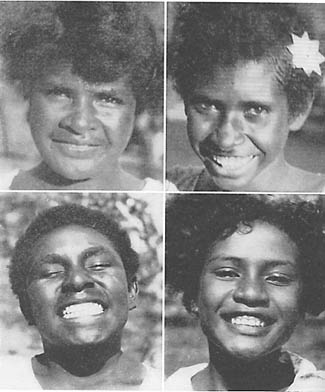
Isolated and modernized Torres Strait islanders
IN STUDYING the relationship between nutrition and physical characteristics, it is important to make observations at the point of contact with civilization where as few factors as possible in the environment have been modified by that contact. My previous studies have shown that wherever groups of people were utilizing sea foods abundantly in connection with land plants including roots, greens and fruits, they enjoyed fine physical development with uniform reproduction of the racial pattern and a very high immunity to dental caries. For this particular study we wished to select a racial group living on islands in tropical or subtropical climate, whose ancestral stocks differed from those previously observed, and which was located at points of contact with modern civilization. A high level of excellence might be expected among the groups who were in process of being modernized but were still utilizing the native foods.
For this study the inhabitants of islands north of Australia were chosen in order to record the effect on the Asiatic and Malay stocks at the points of contact of the north with the south and of the east with the west. In the Torres Strait there are a number of fertile islands supporting populations of from several hundred to a few thousand individuals each. These groups are in an area of the sea that is well stocked with sea animal life, and during the past they have been sufficiently isolated to provide protection. The racial stocks have retained their identities and include Papuans, New Guineans, Mobuiags, Arakuns, Kendals and Yonkas. The splendid dental arches of these groups will be seen in the various illustrations. Many of the girls are quite prepossessing, as may be seen in Fig. 61.

With the valuable assistance of the officials of the Australian Government we were able to make investigations on several islands in the Torres Strait. The local administrator provided us with a government boat and personal introductions to the local chief and local representatives of the government. We were accompanied by the administrator and by the general manager of the government stores. These stores have been located on the various islands, and the profit derived from them is used for administrative expenses of the government. They provide modern clothing in addition to foods, chiefly white flour, polished rice, canned goods, and sugar. Studies were made on the various islands in the order in which the stores had been installed on them. It is important to have in mind the nature of these islands. Some are of volcanic origin and have rugged interiors with deep bays; others are of coral origin. All are in a zone that is abundantly supplied with sea animal life, this being the scene of the richest pearl fishing industry in the world.
Badu Island had had the store for the longest period, namely twenty-three years. Of the 586 teeth of twenty individuals examined, 20.6 per cent had been attacked by tooth decay. Of the individuals examined 95 per cent had dental caries. Unfortunately, our stay at this island was accompanied by a torrential downpour which made it very difficult for us to carry forward our investigations. Had we been able to examine the mothers the figures doubtless would have been much higher. The children were examined at the school and showed 18.8 per cent of the teeth to have been attacked by tooth decay. The men examined showed 21.9 per cent. Figures given me by Dr. Gibson, who had been taken by the government to the island to make extractions, showed that he found as high as 60 per cent of the teeth had been attacked by tooth decay. For the children of this group, 33.3 per cent had abnormal dental arches, whereas only 9.1 per cent of the adults' arches were abnormally formed.
On York Island, 1,876 teeth of sixty-five individuals showed that 12.7 per cent had been attacked by tooth decay. For the women, this was 20.2 per cent; for the men, 12.1 per cent; and for the children, 7 per cent. For the children, 47.1 per cent had abnormal dental arches; for the adults, 27 per cent were affected. The individuals on this island had been in contact with the pearl fisheries industry for several years. Several of the men had been working on the fishing boat. Of the sixtyfive individuals examined, 67.6 per cent had dental caries.
On Darnley Island, thirty-three individuals showed that of their 900 teeth 5.7 per cent had been attacked by tooth decay. The store had been established on this island recently. For the women, 16.6 per cent of the teeth had been attacked; for the men, 6.3 per cent; and for the children, 4.1 per cent. On this island, 29.6 per cent of the children showed abnormal dental arches, and 14.3 per cent of the adults. Of the whole group, 46.1 per cent had been attacked by dental caries.
On Murray Island where a store had recently been established, of the 1,074 teeth examined for 39 individuals, only 0.7 per cent of the teeth had been attacked by tooth decay. For the women, this amounted to 2 per cent; for the men, 1.7 per cent; and for the children, 0.26 per cent. Only 12.8 per cent of the group had dental caries. It is significant that the natives were conscious of a danger from the presence on the island of a store providing imported foods. This had been so serious a problem that there was a question whether it would be safe for us to land, since on the last visit of the government officials, blood was almost shed because of the opposition of the natives to the government s program. The result of our examination indicates that dental caries on these islands shows an incidence which has an apparent direct relationship to the length of time government stores have been established there. The immunity to dental caries on this island is nearly 100 per cent. Of the adults, 14.3 per cent had abnormal dental arches, and of the children, 34.4 per cent.
Thursday Island is the location of the administrative center for the group. Although it is the best sheltered harbor and affords protection for small boats in the Torres Strait, it was not originally inhabited by the natives. They considered it unfit for habitation because the soil was so poor that it could not provide the proper plant foods to be eaten with the sea foods which are abundant about all of the islands. Nearly all of the whites inhabiting the islands of this district live on this island. They are the families of the administrative officers and of merchants who are engaged in the pearl industry. Owing to the infertility of the soil, practically all of the food has to be shipped in except the little that the whites obtain from the sea. On the island there were many native families, with children attending the native school, while their fathers worked in the pearling fleets. Thirty individuals in three fleets were examined, and of their 960 teeth only thirty-five had been attacked by dental caries, or 3.6 per cent. Of these thirty individuals, five, or 16.3 per cent had abnormal dental arches. The men who had teeth attacked by dental caries informed me that this had happened after they had engaged on the pearling vessels and began to use the foods provided there. In the native school on Thursday Island twenty-three children were examined. They were living in homes in which a considerable part of the food was purchased at the company stores. The incidence of tooth decay was 12.2 per cent of their 664 teeth. Many of these Thursday Island children had been born since their parents had begun using the commercial foods provided to the islanders. Among twenty-three individuals, 43.5 per cent had abnormal dental arches.
While these investigations were planned and carried out primarily to obtain data on the condition of the native races in contact with modern white civilization, wherever possible, data were obtained on the whites also. In a school for whites on Thursday Island, fifty children were examined with regard to their dental arches, but an embarrassing situation was encountered with regard to the sensitiveness of the whites in the matter of having their children examined for dental caries. Figures were obtained for the facial development which reveal that, out of the fifty children examined, 64 per cent had irregularities of facial and dental arch development. In the upper half of Fig. 62, will be seen a group of children photographed in the native school, and in the lower a group of white girls photographed at the white school. The difference in their facial development is readily seen. The son of the white teacher (Fig. 66, left) had marked under development of his face. The white population lived largely on canned food.
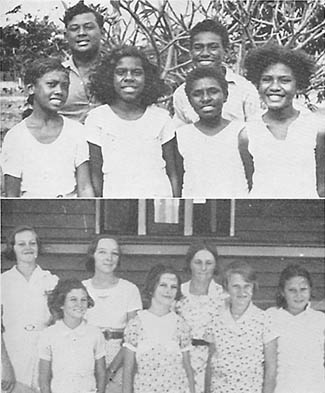
Hammond Island adloins Thursday Island sufficiently close by to be easily reached in small boats. Accordingly, the people of this island have access to the stores of the white settlement on Thursday Island. Unlike Thursday Island, Hammond Island is quite fertile. Of twenty-seven individuals, all of native stock, 16.5 per cent of their 732 teeth had been attacked by dental caries, and 40 per cent of the individuals showed some deformity of the dental arches. After examining the children at the mission school, I inquired whether there were not families on the island that were living entirely isolated from contact with modern influences. I was taken to the far side of the island to an isolated family. This family had continued to live on their own resources. They were raising vegetables including bananas, pumpkins, and pawpaws. In the cases of the three girls in the family, one with a child five months of age, only six of their eighty-four teeth had been attacked by tooth decay, or 7.1 per cent, as compared with 16.5 per cent for the entire group on this island. These three girls all had normally developed dental arches and normal features. Three of the girls are shown in Fig. 63. We inquired about the mother and were told that she was out fishing, notwithstanding the fact that the sea was quite rough. While we were there, she came in with two fish (Fig. 63). Here was one of the principal secrets of their happiness and success in life. The Catholic priest who had charge of the mission on this island told me that this family practically never asked for assistance of any kind, and was always in a position to help others. They were happy and well nourished. It is important to note that the progressive degeneration in facial form which occurred in many of the families on the other islands was not found in this family.
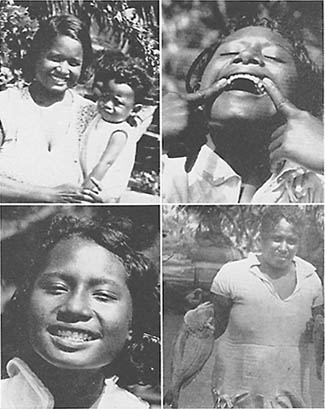
The incidence of dental caries ranged from 20.6 per cent of all of the teeth examined for the various age groups on Badu Island to 0.7 per cent, on Murray Island. A group of individuals from this island will be seen in Fig. 64. Note the remarkable width of the dental arches. Note also in this connection that the natives of this island are conscious of the superior food of their locality and wish that their people were not required to purchase food from the government store. The island is situated on the Barrier Reef and has an abundant supply of small fish. The swarms of fish are often so dense that the natives throw a spear with several prongs into the school of fish and when the spear is drawn back, there are several fish on it. This condition provides abundant food for sharks many of which could be seen surrounding the schools of small fish. Encircling the group, they dashed in, mouths open and gorged themselves with the mass of fish from the water. It seemed quite remarkable that the people were willing to go into the water to spear the fish within the zone frequently approached by the sharks, but I was told by the natives that when the fish are so abundant the sharks never attack human beings. One of the natives rowed me in his canoe to a point where I could photograph the sharks at close range. To show his disdain for the shark, he had no hesitancy in standing up in the end of the canoe and hurling his spear into the side of the monster. The spear was immediately thrown out by the shark, which had not been frightened sufficiently to make it leave the scene of action. The sharks in my pictures were swimming so close to the shore that the upper part of the tail was forced out of the water, also the back fin, in order to clear the bottom. It was a great revelation to watch the movement of the tail. Instead of swinging it from side to side like other fish, with which I was familiar, the shark would rotate its tail half or three quarters of a turn in a motion like that of a propeller of a boat, then reverse the motion for the return trip. By a sudden increase of speed in this motion, the shark could dart ahead at a rapid rate, corral the small fish by encircling them, and finally make a dash through the school with its mouth open. Hundreds of the small fish, in order to escape, dart out of the water into the air. This exposes them to the birds, a flock of which follows the sharks when they are feeding on the fish. The birds dive down at the time they see the shark making his raid and catch the small fish as they dart out of the water. It is by the birds of prey that the native fishermen from their lookout locate the schools of fish. While there is a difference of opinion as to whether some species of shark will attack human beings, we saw one pearl diver who bore enormous scars received from the jaws of a shark.
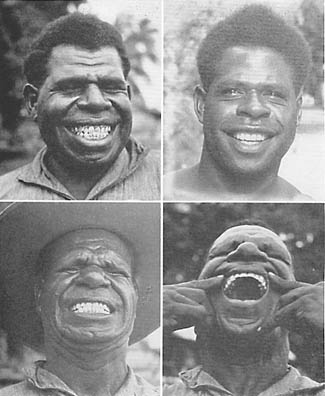
The procedure on one island is to snare the sharks by calling them by means of special sounds made by clapping together two large half shells on the surface of the water. This attracts the shark, and then the men one at a time go into the water with a sharp stick with which they guard themselves against attack. A noose made of rope of coconut fiber is slipped over the shark's head and over the back fin. It is then allowed to tire out and is brought to shore. It was not unusual in a good season for the shark fishers to bring in three or four in a night's fishing. The strength of the native swimmers is almost beyond belief. The pearling boats are frequently in great danger of being dashed to pieces on a coral reef, since in those waters gales of fifty miles an hour are frequent. We experienced some such gales. On one occasion, when a pearling boat was wrecked some distance from an exposed rock, one strong swimmer rescued and helped two dozen of the crew to the rock, and was himself rescued after being in the water continuously for thirty-two hours. The pearling boats feed their crew largely on commercial provisions. When the men have been continuously on the boats for one or two years, or often when they have been at sea using this food for six months, they have rampant tooth decay. When the cavities approach or reach the pulp chambers the pain produced in the teeth by the high pressure in deep water produces such agony that they often have to give up pearling.
Physical characteristics of all these residents of the Torres Strait Islands, regardless of their tribal group, were, sturdy development throughout their bodies, broad dental arches, and for all of those who had always lived only on their native food, a close proximity to one hundred per cent immunity to dental caries. These men are natural mariners. They do not hesitate to make long trips even in rough seas in their homemade crafts. They have an uncanny skill in determining the location of invisible coral reefs. They relate the height of the swell as it rolls over the reef to particular color tones in the water, all of which were too vague for me to see even when they were pointed out.
Among the inhabitants of the Torres Strait Islands, almost all individuals who had been born before the foods of modern civilization had become available were found to have dental arches normal in form. In many families, however, living on islands where a store had been established for some time, and on Thursday Island where imported foods had been available for several decades, many individuals were found who had been born since the use of imported foods. They had gross deformities of the dental arches. This fact is illustrated in Fig. 65 in which typical depression of the laterals and narrowing of the upper arch and abnormal prominence of the cuspids due to the lack of space for the normal eruption may be seen. The facial deformity in two white boys is seen in Fig. 66. Rampant tooth decay in white children is shown in Fig. 67.
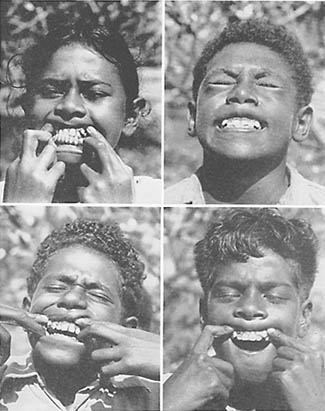
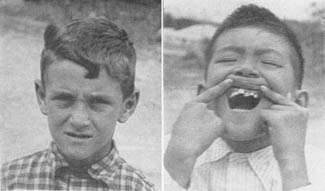
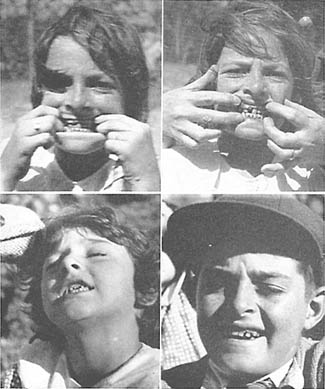
We are particularly concerned with data that will throw light on the nature of the forces responsible for the production of these deformities. Since they do not appear to their full extent until the eruption of the permanent teeth as part of the development of the adult, it is easy for the abnormality to be ascribed to the period of child growth. As a result, it has been related to faulty breathing habits, thumb sucking, posture, or sleeping habits, of the child.
It would be difficult to find a more happy and contented people than the primitives in the Torres Strait Islands as they lived without contact with modern civilization. Indeed, they seem to resent very acutely the modern intrusion. They not only have nearly perfect bodies, but an associated personality and character of a high degree of excellence. One is continually impressed with happiness, peace and health while in their congenial presence.
These people are not lazy, but they do not struggle over hard to obtain food. Necessities that are not readily at hand they do not have. Their home life reaches a very high ideal and among them there is practically no crime.
In their native state they have exceedingly little disease. Dr. J. R. Nimmo, the government physician in charge of the supervision of this group, told me in his thirteen years with them he had not seen a single case of malignancy, and had seen only one that he had suspected might be malignancy among the entire four thousand native population. He stated that during this same period he had operated several dozen malignancies for the white population, which numbers about three hundred. He reported that among the primitive stock other affections requiring surgical interference were rare.
The environment of the Torres Strait Islanders provides a very liberal supply of sea foods and fertile islands on which an adequate quantity of tropical plants are readily grown. Taro, bananas, papaya, and plums are all grown abundantly. The sea foods include large and small fish in great abundance, dugong, and a great variety of shellfish. These foods have developed for them remarkable physiques with practically complete immunity to dental caries. Wherever they have adopted the white man's foods, however, they suffer the typical expressions of degeneration, such as, loss of immunity to dental caries; and in the succeeding generations there is a marked change in facial and dental arch form with marked lowering of resistance to disease.
Next
Table of Contents
Back to the Small Farms Library